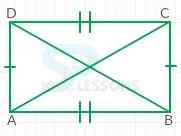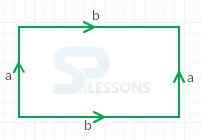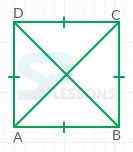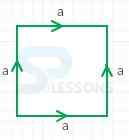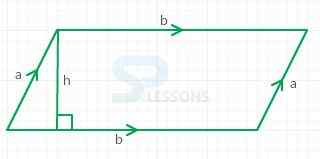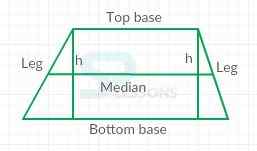 Introduction
Introduction
A four sided polygon with four right angles is known as quadrilateral. The sum of angles of a quadrilateral is 360 degrees. There are five different types of quadrilaterals that pop up on the test. They are trapezoids, parallelograms, rectangles, rhombuses, and squares.
Figures in this section share properties of parallelograms. That is, they all have
- (1) Opposite sides that are parallel,
(2) Opposite angles that are congruent,
(3) Opposite sides that are congruent,
(4) Consecutive angles that are supplementary, and
(5) Diagonals that bisect each other.
Quantitative Aptitude -BANKING|SSC|RAILWAYS|INSURANCE|RECRUITMENT EXAMS - EBOOKS
 Concepts
Concepts
Types of quadrilaterals:
Rectangle: A four sided polygon having all right angles is known as rectangle. The sum of the angles of a rectangle is 360 degrees.
(or)
A rectangle is a parallelogram with four right angles, two pairs of congruent opposite sides, and two congruent diagonals.
From the above figure,
- [latex]\overline{AB} \parallel \overline{DC}[/latex]
- [latex]m \overline{AB}[/latex] = [latex]m \overline{DC}[/latex]
- [latex]m \overline{AC}[/latex] = [latex]m \overline{BD}[/latex]
- [latex]m\angle[/latex]A = [latex]m\angle[/latex]B = [latex]m\angle[/latex]C = [latex]m\angle[/latex]D = [latex]{90}^{\circ}[/latex]
- All four angles of a rectangle are right angles.
- The diagonals of a rectangle are congruent.
- [latex]\overline{AB} \parallel \overline{DC}[/latex]
- [latex]m \overline{AB}[/latex] = [latex]m \overline{DC}[/latex]
- [latex]m \overline{AC}[/latex] = [latex]m \overline{BD}[/latex]
- [latex]m\angle[/latex]A = [latex]m\angle[/latex]B = [latex]m\angle[/latex]C = [latex]m\angle[/latex]D = [latex]{90}^{\circ}[/latex]
- Diagonals bisect each other at right angles and are equal in length.
- Diagonals bisect the vertex angles to create [latex]{45}^{\circ}[/latex] angles.
- Formula for the area of a square is A = [latex]a^2[/latex].
- formula for perimeter of a square is P = 4[latex]a[/latex].
- [latex]\overline{AB} \parallel \overline{DC}[/latex]
- [latex]m \overline{AB}[/latex] = [latex]m \overline{BC}[/latex] = [latex]m \overline{CD}[/latex] = [latex]m \overline{DA}[/latex]
- [latex]\overline{AD} \parallel \overline{BC}[/latex]
- [latex]AC \perp BC[/latex]
- [latex]m\angle[/latex]A = [latex]m\angle[/latex]C
- [latex]m\angle[/latex]ABO = [latex]m\angle[/latex]CBO =[latex]m\angle[/latex]ADO = [latex]m\angle[/latex]CDO
- [latex]m\angle[/latex]B = [latex]m\angle[/latex]D
- [latex]m\angle[/latex]BAO = [latex]m\angle[/latex]DAO =[latex]m\angle[/latex]BCO = [latex]m\angle[/latex]DCO
- Trapezoid is a convex quadrilateral with exactly one pair of parallel sides.
- Bases are the parallel sides, and the legs are non parallel sides.
- Altitude (or height) is the segment perpendicular to the bases.
- Median is the segment connecting the mid points of the legs.
- Trapezoid with congruent legs is an isosceles trapezoid. Since legs are congruent, both pairs of the base angles are also congruent.
- The sum of the measures of the four interior angles is always 360 degrees. Further more, the same side interior angles between the bases are supplementary. [latex]m\angle[/latex]A + [latex]m\angle[/latex]B + [latex]m\angle[/latex]C + [latex]m\angle[/latex]D = [latex]{360}^{\circ}[/latex] [latex]m\angle[/latex]A + [latex]m\angle[/latex]D = [latex]{180}^{\circ}[/latex] [latex]m\angle[/latex]B + [latex]m\angle[/latex]C = [latex]{180}^{\circ}[/latex]
 Formulae
Formulae
1. Rectangle:
Perimeter = 2([latex]a[/latex] + [latex]b[/latex])
Area = [latex]a[/latex] x [latex]b[/latex]
2. Square:
Perimeter = [latex]a[/latex] + [latex]a[/latex] + [latex]a[/latex] + [latex]a[/latex] = 4[latex]a[/latex]
Area = [latex]a[/latex] x [latex]a[/latex] = [latex]a^2[/latex]
3. Parallelogram:
Perimeter = [latex]a[/latex] + [latex]b[/latex] + [latex]a[/latex] + [latex]b[/latex] = 2([latex]a[/latex] + [latex]b[/latex])
Area = [latex]b[/latex] x [latex]h[/latex]
4. Rhombus:
Perimeter = [latex]s[/latex] + [latex]s[/latex] + [latex]s[/latex] + [latex]s[/latex] = 4[latex]s[/latex]
Area = [latex]\frac{a * b}{2}[/latex]
5. Trapezoid:
Perimeter = [latex]a[/latex] + [latex]b[/latex] + [latex]c[/latex] + [latex]d[/latex]
Area = [latex]\frac{1}{2}[/latex] x ([latex]b[/latex] + [latex]d[/latex]) x [latex]h[/latex]
 Samples
Samples
1. If the length of rectangle A is one-half the length of rectangle B, and the width of rectangle A is one-half the width of rectangle B, what is the ratio of area of rectangle A to the area of rectangle B?
Solution:
A. The quantity on the left is greater.
B. The quantity on the right is greater.
C. Both are equal.
D. The relationship cannot be determined without further information.
Solution:
A. The quantity on the left is greater.
B. The quantity on the right is greater.
C. Both are equal.
D. The relationship cannot be determined without further information.
Solution:
- Given that,
The length of rectangle A is one-half the length of rectangle B.
The width of rectangle A is one-half the width of rectangle B.
The ratio of areas is not the same as the ratio of lengths. Instead, the ratio of areas for similar polygons is equal to the square of the lengths of the lengths.
If the length and width of a rectangle are 4 and 2, then its area = 8.
Rectangle B would have area of 8 x 4 = 32 four times that of A.
- I. Number of photos she can mount.
II. Number of photos she does not have enough board to mount.
- Given that,
Sally has 48 square inches of matting board to work with.
Stack of five rectangular photos each measuring 3 x 5.
Each photo require 15 sq. inch of mounting board since A = [latex]lw[/latex] = 3 x 5 = 15.
Where, [latex]l[/latex] is length and [latex]w[/latex] is width.
I. Number of photos she can mount:
If three photos are mounted, then 15 x 3 = 45 sq.in. of matting board.
II. Number of photos she does not have enough board to mount:
Since Sally started with 48 sq. in. of board,
Using 45 sq.in. in will leave her 3 sq.in. left over which is not enough to mount a fourth photo.
Mounting 3 of five photos will leave her with 2 unmounted photos.
- Tiles are measured in inches, so convert the area of the floor to inches as well.
The length of the floor is 9 ft x 12 inch per foot = 108 inch.
The width of the floor is 11 ft x 12 inch per foot = 132 inch.
Area of rectangle = length x width.
Therefore, area of kitchen floor is 108 inch x 132 inch or 14,256 sq.inch.
Area of one tile is 6 inch x 6 inch or 36 sq.inch.
Therefore, divide the total number of square inches by 36 sq. inch or 14,256 sq.inch divided by 36 sq.inch = 396 tiles.
| Quantity A | Quantity B |
| If the area of a rectangle is 12. What is its perimeter? | 16 |
- Length and breadth are not given.
Length and breadth could be any thing only thing is their double of sum should be 12.
So, it is impossible to calculate perimeter.
The given information is insufficient to solve the problem.
Hence, option B is correct one.
| Quantity A | Quantity B |
| 120 sq. ft. | The total area of the pool and deck. |
- Given that
Length = 12 feet and
Width = 8 feet
Area of rectangle (A) = [latex]lw[/latex]
A = 12 x 8
A = 96 sq. ft.
Now, add area of deck to this area i.e. 36 + 96 = 132 sq. ft.
132 sq. ft is more than value of quantity A i.e. 120 sq. ft.
Hence, correct option is B.






